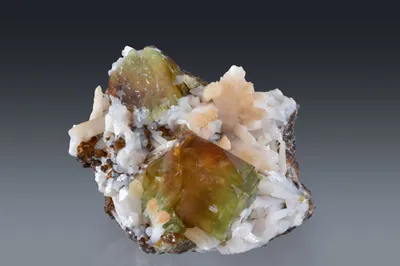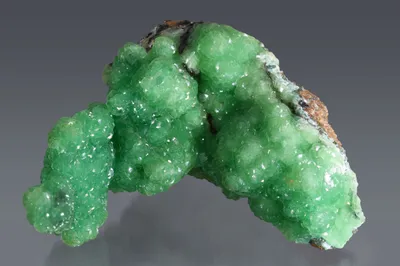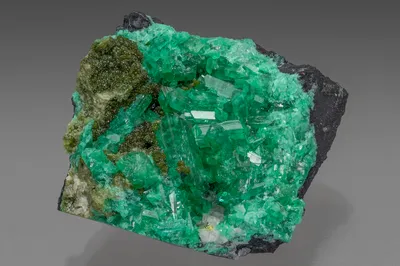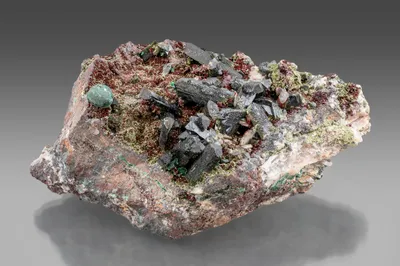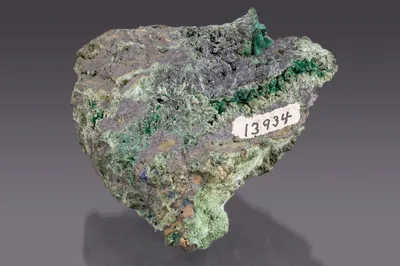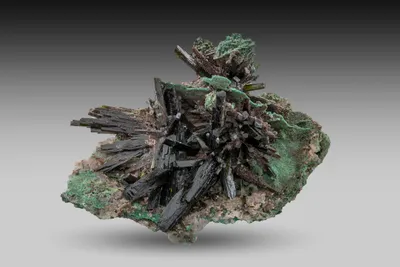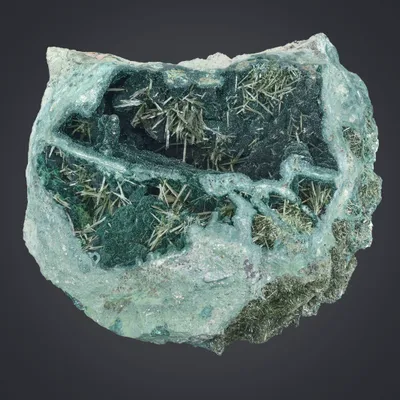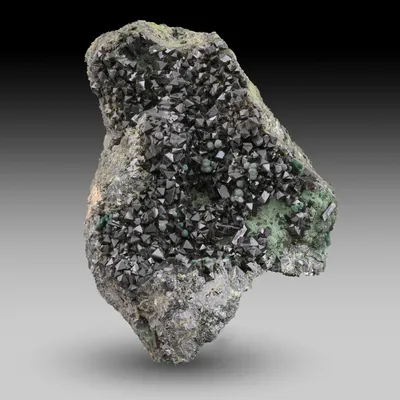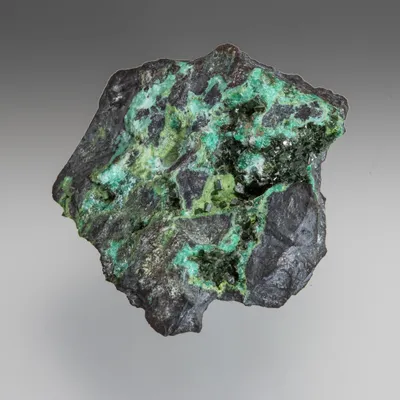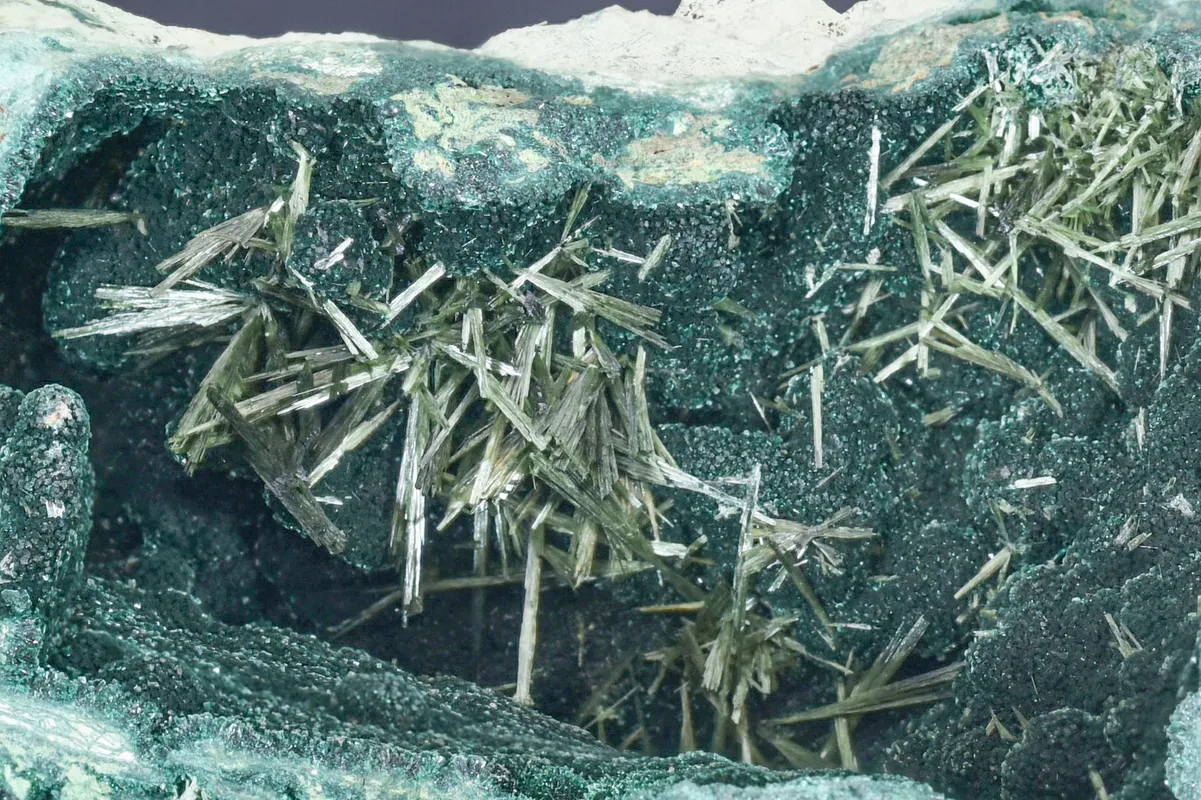
Image Credit: Malcolm Southwood
Mineral Species
Olivenite
Type Locality
No
Composition
Cu2+2(AsO4)(OH)
Crystal System
Monoclinic
Status at Tsumeb
Confirmed
Abundance
Somewhat rare
Distribution
First, second and third oxidation zones
Paragenesis
Supergene
Entry Number
Species; TSNB258
General Notes
Olivenite is the copper-rich end-member of the adamite-olivenite solid solution series and is defined as having a copper content of > 75 mol % (or Zn < 25 mol %). At Tsumeb, olivenite, senso stricto, is considerably less common than zincolivenite, the intermediate member of the series (Chukanov et al. 2007). Zincolivenite was previously and informally referred to as cuproadamite, cuprian adamite or sometimes zincian olivenite (Southwood et al. 2020).
Olivenite was recognised from the very early days of mining at Tsumeb (Maucher 1908a) and was apparently considerably more abundant in the first oxidation zone than in the second, (although the reverse is true for zincolivenite). Maucher (1908a) described small olive-green crystals of olivenite and recognised that the colour lightened with a higher zinc content, which also resulted in better-developed crystals.
Klein (1938) made the observation that olivenite was common between surface and a depth of 100 m (i.e., 4 Level), typically associated with azurite and malachite and mainly as radial masses, sometimes with drusy surfaces of crystal terminations.
Klein’s collection (now at MGMH, Harvard University) included 15 specimens of olivenite, all of which were from either 4 Level East or the open pit (Klein catalogue; unpublished; Klein family archive). One outstanding specimen from the open pit (MGMH 106045; [Klein 1050]) consists of acicular crystals of olivenite (to 25 mm) on a matrix of massive malachite and unidentified arsenates. A very similar specimen from the Kegel Collection is conserved at the Smithsonian Institution in Washington D.C. (NMNH R8600). This habit of olivenite, as large acicular crystals, does not appear to have been found in deeper parts of the mine.
Bartelke (1976) reiterated Klein’s (1938) description of first oxidation zone olivenites but noted the occurrence of emerald-green zinc-rich olivenite (= zincolivenite) and black-green iron-rich olivenites in the second oxidation zone.
Pinch and Wilson (1977) considered olivenite relatively common in both oxidation zones as "… olive-green to brownish-green crystals … some of which are the finest olivenite specimens in the world, and reach 2.5 cm. The habit is most commonly radially structured masses and prismatic crystals or tabular crystals flattened on the a-axis."
According to Key (1977) "About 4 years ago [c. 1973] three specimens were brought to the U.S. that are probably the finest olivenite specimens ever found anywhere. They consist of brilliant, equant, greenish-black crystals lining vugs in massive chalcocite. The crystals were up to 3/8 inch size [= c. 1 cm]." One of these specimens, formerly in the Pinch Collection, is now in the collection of the Canadian Museum of Nature in Ottawa (CMNMC 56743) and is figured by Bainbridge (2020; page 66).
Keller (1984) noted that groups of sub-parallel olivenite crystals are often radially fused to form attractive divergent sprays. He also recorded the exceptional occurrence of a very few prismatic olivenite crystals to 50 mm in length. Von Bezing et al. (2016) pointed out that these are some of the largest olivenite crystals from any locality.
Keller (1977a) observed that olivenite is associated with fewer other secondary minerals than adamite and zincolivenite. For olivenite he considered azurite, malachite and mottramite as common associates, duftite and quartz as "less-common" associates, and cuprite, smithsonite, adamite and conichalcite as rare or very rare associates.
Keller (1977a) noted that adamite/zincolivenite is commonly associated with conichalcite, on which basis he included adamite (and by implication zincolivenite) in three of his Type II (lower pH) paragenetic sequences, while placing olivenite (which is more commonly found with mottramite) in one of his Type I (near-neutral pH sequences):
I/8: quartz >> mottramite >> olivenite(i & ii) >> duftite >> malachite >> azurite >> malachite (ps. azurite)
Associated Minerals
adamite; andyrobertsite; azurite; bayldonite; beudantite; calcioandyrobertsite; calcite; cerussite; chalcocite; chenevixite; chudobaite; conichalcite; cuprite; cornwallite; dolomite; duftite; ferrilotharmeyerite; gartrellite; hemimorphite; hydrozincite; langite; malachite; metazeunerite; mottramite; posnjakite; quartz; rosasite; silver; smithsonite; stranskiite; tennantite-(Zn); yvonite (?); zincgartrellite; zincolivenite
Pseudomorphs
Olivenite is reported to form pseudomorphs after the following minerals: bayldonite (rare).
The following minerals are reported to form pseudomorphs after olivenite: adamite (rare, possible confusion with zoned crystals).

